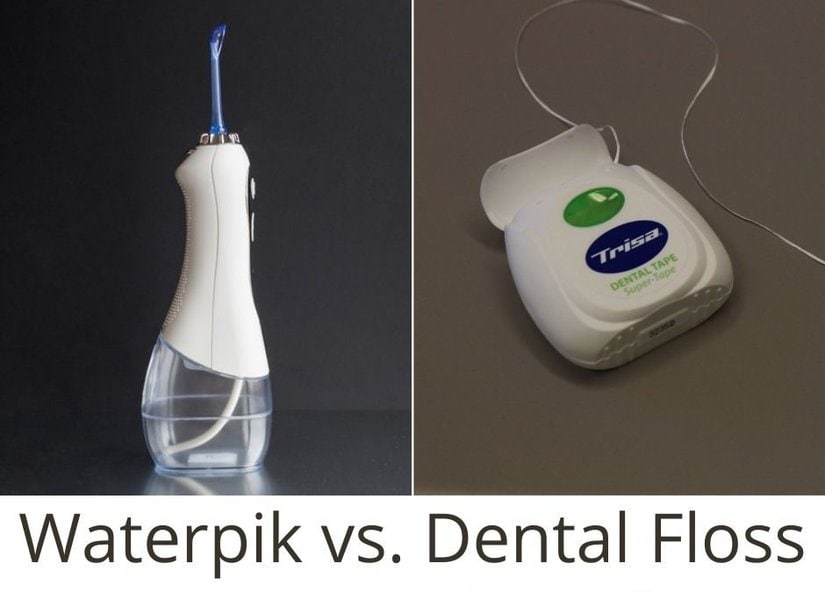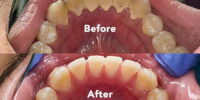Waterpik Vs. Flossing – The Great Comparison

You’ve heard it a million times: brush your teeth, floss, and rinse. But have you ever heard of waterpik? Waterpik is an alternative to flossing that is becoming increasingly popular.
In this article, we’ll compare waterpik and flossing to help you decide which is best for you. We’ll look at the benefits and drawbacks of each and compare cost and effectiveness.
After reading this article, you’ll have the information you need to make an informed decision.
So let’s get started!
What Is Waterpik?
Are you curious about what sets this alternative to flossing apart? Waterpik is a dental device that uses a stream of pressurized water to remove plaque from teeth and gums. It is an easy and effective way to keep your mouth healthy and prevent tooth decay and gum disease.
Generally, a Waterpik device consists of a handheld unit connected to a water reservoir and a long, thin nozzle. The user holds the nozzle in the mouth, turns on the machine, and the water streams out of the nozzle to get rid of the plaque. Using a Waterpik is simple and does not require any special skills.
It is also a great way to remove food particles and debris that can accumulate between teeth. It is important to note that waterpik is not a replacement for flossing, but rather an alternative that can help supplement and improve flossing.
What Is Flossing?
Flossing is an easy and effective way to maintain your oral health, so it’s definitely worth giving it a try!
Flossing is the process of cleaning between your teeth, usually with a thin strand of plastic or waxed nylon thread. It can help remove plaque and food particles that can get stuck in the small spaces between teeth.
It’s important to floss at least once a day, making sure to go between each tooth and under the gumline. Flossing can be done with disposable flossers or plain floss, whichever you prefer.
Doing a thorough job of flossing can help keep your mouth healthy and reduce your risk of gum disease and tooth decay. Plus, it only takes a few minutes each day, so it’s definitely worth it!
Benefits of Waterpik
You’ll be surprised to learn how beneficial a Waterpik can be for your oral hygiene routine! Using a Waterpik can help you get rid of food particles and bacteria that can get stuck between your teeth and gums. It’s an effective and efficient way to get rid of this debris, and it does so much more.
Waterpiks can also help reduce plaque, which can help prevent the onset of gum disease. Moreover, they can help improve your breath and give you a fresh feeling after every use. Additionally, Waterpiks can help improve the overall health of your gums, and can even strengthen them. This can help reduce the risk of gum recession, which can result in the loss of teeth.
Overall, using a Waterpik can be a great way to keep your mouth healthy and clean.
Benefits of Flossing
Flossing is an essential part of your oral hygiene routine, and it can help keep your teeth and gums healthy and clean. Regular use of dental floss can:
- Remove food particles and plaque from hard-to-reach areas between your teeth.
- Prevent gum disease and gingivitis by reducing the build-up of plaque along your gum line.
- Promote healthy teeth and gums by helping to remove bacteria, plaque, and other debris that can cause tooth decay and gum disease.
Flossing is a simple and effective way to help prevent cavities and gum disease, and it’s an essential part of any oral hygiene routine. It can also help to reduce bad breath caused by bacteria in the mouth, as well as help keep your teeth and gums healthy and clean.
Drawbacks of Waterpik
If you’re looking for an alternative to traditional flossing, a Waterpik may be a good option for you. However, there are some drawbacks to using this type of device.
Waterpiks are generally more expensive than floss, and you’ll need to replace parts or buy a new machine every few years. Additionally, they can be quite noisy, making it difficult to use them in the morning or evening when others are trying to sleep.
If you have braces, a Waterpik may not be as effective as flossing since braces can be difficult to clean with the device. Furthermore, if you have an infection or other dental issues, Waterpiks may not be able to adequately remove the debris and bacteria, making them less effective than traditional flossing.
In summary, Waterpiks can be a useful alternative to flossing, but they have their own drawbacks that should be considered.
Drawbacks of Flossing
Despite being a common and often recommended dental hygiene practice, flossing can come with drawbacks that should be taken into consideration.
Many people struggle with using floss correctly, leading to ineffective results and unnecessary discomfort. Additionally, flossing can lead to issues like bleeding gums and can cause damage to sensitive teeth.
Flossing requires a lot of patience and dexterity and can be difficult for those with physical limitations. Those with braces and other dental hardware may find it difficult to maneuver the floss around the hardware, making it difficult to clean properly.
It can also be time-consuming and tedious for many, leading people to become discouraged and give up on flossing altogether. In addition, flossing can be expensive, as a steady supply must be purchased and replaced regularly.
Comparing Cost and Effectiveness
Now, let’s compare the cost and effectiveness of waterpik and flossing. You may be wondering which one is better for your wallet and your teeth.
The cost of a waterpik is usually more expensive than flossing. However, a waterpik is a more efficient way to clean your teeth, as it can clean more areas of your teeth at once. A waterpik also uses less time than flossing, meaning you don’t have to spend as much time in the bathroom every day.
On the other hand, flossing can be more cost-effective in the long run, as it is a more affordable option and only requires the purchase of floss. Flossing can also be more effective for cleaning between teeth, as the floss can reach more areas than a waterpik can.
In the end, it comes down to personal preference and budget.
Choosing the Best Option for You
Deciding between a waterpik and flossing ultimately comes down to personal preference and budget, so it’s important to consider both options carefully before making a choice.
Here are some things to keep in mind when making your decision:
- Consider the cost of the device and the cost of replacement parts and tips.
- Consider the amount of time needed for the task.
- Determine if you need a waterpik that can be used in the shower and/or one with multiple tips.
- Consider the noise level of the device and whether or not it’s too loud for you.
- Think about whether or not you’d prefer to have a device that’s cordless or one that plugs into the wall.
Ultimately, the choice between a waterpik and flossing comes down to what works best for your needs and budget. It’s important to weigh all of the factors carefully to make sure that you’re making the best decision for your oral health.
Conclusion
You’ve heard about waterpik and flossing, but which one is best for you?
When it comes to cost and effectiveness, both have their benefits. Waterpik is more expensive but can be more effective. Flossing is cheaper but may take more time and effort. Ultimately, the choice is yours.
Whichever one you choose, make sure you stick with it and keep up with it. Regular brushing and flossing is key to maintain good oral health. So why not give both a try and see which one works best for you? After all, the best option is the one that works best for your unique oral health needs.









